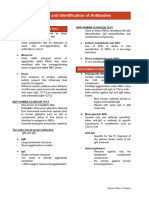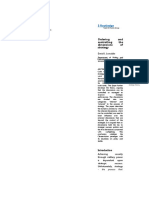0 ratings0% found this document useful (0 votes)
33 viewsMLSP Isbb
MLSP Isbb
Uploaded by
mariakrishajewelfranciscoThe document discusses immunology, serology, and blood banking. It covers topics like antigens, antibodies, immunoglobulins, specimen collection and transport, and tests performed in immunology/serology and blood banking sections. Regulations for transporting suspected infectious specimens from DOT and IATA are also mentioned.
Copyright:
© All Rights Reserved
Available Formats
Download as DOCX, PDF, TXT or read online from Scribd
MLSP Isbb
MLSP Isbb
Uploaded by
mariakrishajewelfrancisco0 ratings0% found this document useful (0 votes)
33 views3 pagesThe document discusses immunology, serology, and blood banking. It covers topics like antigens, antibodies, immunoglobulins, specimen collection and transport, and tests performed in immunology/serology and blood banking sections. Regulations for transporting suspected infectious specimens from DOT and IATA are also mentioned.
Original Description:
Isbb reviewer
Original Title
MLSP ISBB
Copyright
© © All Rights Reserved
Available Formats
DOCX, PDF, TXT or read online from Scribd
Share this document
Did you find this document useful?
Is this content inappropriate?
The document discusses immunology, serology, and blood banking. It covers topics like antigens, antibodies, immunoglobulins, specimen collection and transport, and tests performed in immunology/serology and blood banking sections. Regulations for transporting suspected infectious specimens from DOT and IATA are also mentioned.
Copyright:
© All Rights Reserved
Available Formats
Download as DOCX, PDF, TXT or read online from Scribd
Download as docx, pdf, or txt
0 ratings0% found this document useful (0 votes)
33 views3 pagesMLSP Isbb
MLSP Isbb
Uploaded by
mariakrishajewelfranciscoThe document discusses immunology, serology, and blood banking. It covers topics like antigens, antibodies, immunoglobulins, specimen collection and transport, and tests performed in immunology/serology and blood banking sections. Regulations for transporting suspected infectious specimens from DOT and IATA are also mentioned.
Copyright:
© All Rights Reserved
Available Formats
Download as DOCX, PDF, TXT or read online from Scribd
Download as docx, pdf, or txt
You are on page 1of 3
MLSP112 LECTURE: MEDICAL LABORATORY SCIENCE PRACTICE 2
WEEK 8: IMMUNOLOGY, SEROLOGY, AND BLOOD BANKING
2ND SEMESTER | MIDTERM| 2023 – 2024
PROFESSOR: JHASTINE UMALI, RMT
Immunology / Serology Section - The ability to react specifically with the
Immunology antibody or cell that caused it to be produced.
- study of the reactions of a host when foreign Immunogens
substances are introduced into the body. - Molecule that induces an immune response
o Antigen - Non-self
- substances that can induce immune response. It - At least 2 antigenic determinants
can be harmful/harmless. __________________________________________
o Antibody ____
- Serum factors in the blood formed in response
to foreign substance exposure. Haptens
Serology - Molecule that is NOT IMMUNOGENIC by itself
- Study of serum and is known for the qualitative but can react with a specific antibody.
detection or quantitative analysis of antibodies Antibody
or antigens concerning infection or disease - A.K.A Immunoglobulins
diagnosis. o A gamma globulin protein
Basic Concept of Immunity - Produced by “Plasma Cells”
Immunity - Play an essential role during “Antigen
- How the body can protect itself from invasion Recognition” and in biological activities related
by pathogenic microorganisms and provide a to immune response such as “opsonization”
defense against their harmful effect. and “complement activation”.
Classified into two groups: Major Ig Classes
1. Non-Specific Immunity IgG: gamma heavychain
2. Specific Immunity IgA: alpha heavychain
Two Types of Adaptive Immunity
IgM: mu heavychain
Active
IgE: epsilon heavychain
1. Natural Active
IgD: Delta heavychain
- Exposure to subclinical infections
Specimen Preparation and Processing for Serological Test
2. Artificial Active
Blood is collected aseptically by venipuncture into a
- Vaccination
clean, dry, sterile tube.
Passive
Care must be taken to avoid hemolysis, since this may
1. Natural Passive
produce a false positive test.
- Placental Transfer of IgG
Serum should be promptly separated into another
- Colostral Transfer of IgA
tube without transferring any cellular elements.
2. Artificial Passive
Fresh, non-heat inactivated serum is usually
- Antibodies or Immunoglobulins
recommended for testing.
- Immune Cells
o There is a certain serological test that
Antigen vs. Immunogens
requires inactivated serum.
Antigens
o Like VDRL and FTA-Abs
- Molecules that react with antibodies
o Serum should be heated at 56 C for 30
- Compound that does not necessarily elicit an
immune response. minutes.
- Target of response o If testing cannot be performed
Properties of Antigens: immediately 2-8 C for up to 72hrs,
o Immunogenicity -20oC if >72 hours delay.
- Ability to induce a specific response resulting Transporting Patient Specimen
in the formation of antibodies or immune Depending on the scope of testing performed in an
lymphocytes. immunology laboratory, transporting and receiving
patient specimens must be considered.
o Antigenicity / Specificity Regulations for packaging and labeling developed by
OUR LADY OF FATIMA UNIVERSITY
WEEK 8: IMMUNOLOGY, SEROLOGY, AND BLOOD BANKING
the U.S. Department of Transportation (DOT), the for use in a transfusion. Units of blood is
International Air Transport Association (IATA), and the collected from donors, and tested for the
United Nations must be followed. presence of bloodborne pathogens such as
Characteristics of a Transport Container Suspected Infectious hepatitis viruses and human immunodeficiency
Specimen DOT and IATA rules. virus (HIV)
Watertight primary containers made of glass, metal, Blood Components Available for Transfusion
or plastic with a positive (screw-on) cap. Whole Blood
The primary container must be wrapped with enough Packed Red Cells
absorbent material to be capable of absorbing all of Platelet Concentrate
its contents. Multiple specimens must be wrapped Cryoprecipitate
individually before placing them in the leak-proof Fresh Frozen Plasma
secondary container. Sample Collection and Handling
The secondary container is placed in a sturdy outer Blood bank samples are collected in plain red (serum),
container made of corrugated fiberboard, wood, lavender, or pink (plasma) stopper tubes. Serum
metal, or rigid plastic. An itemized list of contents in a separator tubes containing gel are not acceptable
sealed plastic bag is also placed in the outer container. because the gel will coat the RBCs and interfere with
Ice packs are placed between the secondary and the testing. Hemolysis also interferes with the
outer container. Additional measures must be taken interpretation of test results.
when using ice and dry ice. Patient identification is critical in the blood bank, and
___________________________________________________ phlebotomists must carefully follow all patient
In January 2007, the labeling of the outer container identification and sample labeling procedures to
changed. The terms clinical specimen and diagnostic ensure that a patient does not receive a transfusion
specimen have been replaced with biological with an incompatible blood type.
substances, Category B. This wording is placed next to Test Performed in the Blood Bank Section
the label UN 3373.
Governing Agencies in Blood Bank
The American Association of Blood Banks (AABB)-
Tests Performed in Immunology/Serology Section was established in 1947. It is an international
association of blood banks that includes hospital and
community blood centers, transfusion and
transplantation centers, and individuals involved in
transfusion medicine. The mission of AABB is to
establish and provide the highest standard of care for
patients and donors in all aspects of transfusion
medicine.
Blood Bank Section Food and Drug Administration (FDA) inspects blood
- Section in the laboratory where blood may be banks on an annual basis; its regulations for donors
collected, stored, and prepared for transfusion. are outlined in the Code of Federal Regulations, parts
- In the blood bank, blood from patients and 211, 600-799.
donors are tested for their blood group (ABO) ___________________________________________________
and Rh type. Donor Screening
- Encompasses the medical history requirements
for the donor, the physical examination, and
serologic testing of the donor's blood.
Medical History and Physical Examination
- The presence and identity of abnormal It is designed to answer two questions:
antibodies, and its compatibility (crossmatch)
OUR LADY OF FATIMA UNIVERSITY
WEEK 8: IMMUNOLOGY, SEROLOGY, AND BLOOD BANKING
1. Will a donation of approximately 450 mL of whole
blood at this time be harmful to the donor?
2. Could blood drawn from this donor at this time?
potentially transmit a disease to the recipient.
Donor Screening: Medical History
Obtaining an accurate medical history of the donor is
essential to ensure benefit to the recipient.
The interviewer should be familiar with the questions,
and the interview should be conducted in a secluded
area of the blood center.
The questions are designed so that a simple “yes” or
“no” can be answered but elaborated if indicated.
The medical history is conducted on the same day at
the donation.
Medications the donor is taking are present in plasma
and may cause deferral.
Infections the donor has may be passed to the
recipient and may be cause for deferral.
Donor Screening: Physical Examination
Provides a general screening of health and vital signs
to ensure good health on the day of donation.
Specific screening assessments are performed, and
the results are recorded in the donor record.
Criteria for Donor Screening
General Appearance
Observe the prospective donor for the
presence of excessive anxiety, drug or alcohol
influence, or nervousness.
This should be done gently to not deter the
donor from donations in the future.
Temperature
- Less than or equal to 37.5 C or 99.5 F.
Blood Pressure
- Systole: Less than or equal to 180mm Hg.
- Diastole: Less than or equal to 100mm Hg.
Pulse
- 50-100 beats per minute
Hemoglobin
- Greater than or equal to 12.5 g/dL
Hematocrit
- Greater than or equal to 38%
Weight
- 50kg or 110 lbs.
OUR LADY OF FATIMA UNIVERSITY
You might also like
- M&T Bank Statement - 1Document2 pagesM&T Bank Statement - 1Matt Derrick100% (1)
- The Four Temperaments by Rev Conrad Hock PDFDocument33 pagesThe Four Temperaments by Rev Conrad Hock PDFkorrg1234100% (3)
- Immunohematology Trans by KTRC (Wala Ito Sa Book)Document21 pagesImmunohematology Trans by KTRC (Wala Ito Sa Book)Angelo ErispeNo ratings yet
- British Council Core InventoryDocument1 pageBritish Council Core InventoryJosé Henríquez GalánNo ratings yet
- With Immunologic Disorders: Care of ClientsDocument6 pagesWith Immunologic Disorders: Care of ClientsAngela SalacutNo ratings yet
- 3gallergy 2020 - Specific - IgE - Universal - Kit - IMMULITE - 2000 - Systems - Rev - 32 - DXDCM - 09017fe9804a6eb0-1598648757334Document49 pages3gallergy 2020 - Specific - IgE - Universal - Kit - IMMULITE - 2000 - Systems - Rev - 32 - DXDCM - 09017fe9804a6eb0-1598648757334Pierre LavoisierNo ratings yet
- Immunology in Blood BankingDocument10 pagesImmunology in Blood BankingAngel JanorasNo ratings yet
- Immunoserology: Medical Technology Assessment Progam 1 Discussed By: Mr. Mark MendrosDocument8 pagesImmunoserology: Medical Technology Assessment Progam 1 Discussed By: Mr. Mark MendrosLea Juan100% (1)
- Basic Principles of Immunohaematology in Blood BankingDocument60 pagesBasic Principles of Immunohaematology in Blood BankingMandavi HindNo ratings yet
- Immunology practical lecture 1Document2 pagesImmunology practical lecture 1anasrohail266No ratings yet
- El Toxo G.Document6 pagesEl Toxo G.velsedayNo ratings yet
- Fundamentals of ImmunologyDocument3 pagesFundamentals of ImmunologyKenj Yolleth IbañezNo ratings yet
- Sero Technique IMS LABDocument6 pagesSero Technique IMS LABAlexane Noreen D. EreseNo ratings yet
- P-3116 - Immunocytochemistry Lecture Notes PDFDocument26 pagesP-3116 - Immunocytochemistry Lecture Notes PDFSwetha RameshNo ratings yet
- Chapter 1 2Document22 pagesChapter 1 2Krizza UrmazaNo ratings yet
- Antigen and Antibody 050421 For StudentDocument29 pagesAntigen and Antibody 050421 For StudentochotpremNo ratings yet
- UNIT 4 and UNIT 5 ISDocument9 pagesUNIT 4 and UNIT 5 ISMarinelle TumanguilNo ratings yet
- Antiges Antibodies RactionDocument18 pagesAntiges Antibodies RactionHadi AdamNo ratings yet
- 2BBK Lec2 - Blood Group Antigen and Antibody MQA 2019-09-26 08-14-36Document28 pages2BBK Lec2 - Blood Group Antigen and Antibody MQA 2019-09-26 08-14-36gothai sivapragasamNo ratings yet
- Immunochemistry Part 1Document7 pagesImmunochemistry Part 1Anthea AllamNo ratings yet
- LEC 2 Anti Globulin TestDocument2 pagesLEC 2 Anti Globulin TestTintin MirandaNo ratings yet
- Serological Test PrinciplesDocument16 pagesSerological Test PrinciplesDiana Kate GalleroNo ratings yet
- Microbiology 11Document5 pagesMicrobiology 11raffydaifo367No ratings yet
- 2.4. MICROBIAL IDENTIFICATION IMMUNOLOGICAL METHODSDocument30 pages2.4. MICROBIAL IDENTIFICATION IMMUNOLOGICAL METHODSnik nieshaNo ratings yet
- Immunology and Immuno BiotechnologyDocument45 pagesImmunology and Immuno BiotechnologySaravanan RajagopalNo ratings yet
- Antigen-Antibody ReactionsDocument16 pagesAntigen-Antibody ReactionsArshdeep SinghNo ratings yet
- Topic 11 - Hypersensitivity and Autoimmuninty ProblemsDocument7 pagesTopic 11 - Hypersensitivity and Autoimmuninty ProblemsMatt Andrei P. SongcuanNo ratings yet
- Immunology NotesDocument37 pagesImmunology Notesjinoyraju6No ratings yet
- Microbiology 1.02 SerologyDocument16 pagesMicrobiology 1.02 SerologyCamila BarzagaNo ratings yet
- Specific Immune ResponseDocument31 pagesSpecific Immune ResponseShirin GulNo ratings yet
- AlaTOP Allergy Screen OUS - IMMULITE 2000 Systems - Rev 21 DXDCM 09017fe98067cfcb-1645658153157Document28 pagesAlaTOP Allergy Screen OUS - IMMULITE 2000 Systems - Rev 21 DXDCM 09017fe98067cfcb-1645658153157Pierre LavoisierNo ratings yet
- L6 - Detection and Identification of AntibodiesDocument12 pagesL6 - Detection and Identification of AntibodiesEra MargaretteNo ratings yet
- 3.2 Immu AntibodysDocument57 pages3.2 Immu AntibodysUserNo ratings yet
- Cells of The Adaptive Defense SystemDocument5 pagesCells of The Adaptive Defense SystemwarthwalterwhitesbinsNo ratings yet
- ANTIBODY SCREENING - FinalDocument4 pagesANTIBODY SCREENING - FinalHaniya KhanNo ratings yet
- ISBB SummaryDocument7 pagesISBB SummaryNeilJohnL.OrineoNo ratings yet
- AgglutinationDocument5 pagesAgglutinationYzza DerequitoNo ratings yet
- ImmunoserologyDocument3 pagesImmunoserologyanon_686369323No ratings yet
- Part I - ABO and RH BGSDocument6 pagesPart I - ABO and RH BGSbanaderamariankateNo ratings yet
- ImmunityDocument8 pagesImmunityumerabdu604No ratings yet
- Agglutination Reaction: Sensitization Lattice FormationDocument2 pagesAgglutination Reaction: Sensitization Lattice FormationBianca ANo ratings yet
- Agglutination Reaction: Sensitization Lattice FormationDocument2 pagesAgglutination Reaction: Sensitization Lattice FormationBianca ANo ratings yet
- Immunology and Serology Review 2023Document105 pagesImmunology and Serology Review 2023Ronelene GatoNo ratings yet
- IMMUNOHISTOCHEMISTRYDocument13 pagesIMMUNOHISTOCHEMISTRYjulia.ohmy3No ratings yet
- Immunology & Serology Part 2Document17 pagesImmunology & Serology Part 2Michelle San Miguel FeguroNo ratings yet
- Imhm Lec Finals Merge_240918_223205 (2)Document25 pagesImhm Lec Finals Merge_240918_223205 (2)kimberlynavas72No ratings yet
- Kuliah Produksi AntibodiDocument62 pagesKuliah Produksi AntibodiDeuxyNo ratings yet
- Immunological TerminologyDocument9 pagesImmunological Terminologymdjahedhassan305No ratings yet
- S.N. Characteristics Antigen Antibody: Antigen and Antibody Qno1. What Is Difference Between Antigen and Antibody?Document7 pagesS.N. Characteristics Antigen Antibody: Antigen and Antibody Qno1. What Is Difference Between Antigen and Antibody?maheen akramNo ratings yet
- Adobe Scan 12 Aug 2023Document7 pagesAdobe Scan 12 Aug 2023aashiquezainmuhammedNo ratings yet
- Immunology and ImmunohematologyDocument10 pagesImmunology and ImmunohematologymagumveraNo ratings yet
- Microbiology - 15Document8 pagesMicrobiology - 15karmylle andradeNo ratings yet
- IMSE_FINALSDocument7 pagesIMSE_FINALSnpalaurin9339qcNo ratings yet
- 2 Ag Ac 2011 PDFDocument8 pages2 Ag Ac 2011 PDFGigiEnergieNo ratings yet
- Principles of Serological TestsDocument19 pagesPrinciples of Serological TestsBereket Mathewos GeleboNo ratings yet
- Antibody Screening and IdentificationDocument13 pagesAntibody Screening and IdentificationAnonymouscatNo ratings yet
- Immunity Related DisordersDocument34 pagesImmunity Related DisordersSamuel OlamideNo ratings yet
- Immunosero Trans2Document4 pagesImmunosero Trans2Jan Francis Kevin YasisNo ratings yet
- Trend in Laboratory Diagnostic For AllergyDocument29 pagesTrend in Laboratory Diagnostic For Allergygonteng sadyogaNo ratings yet
- Adilah Firdaus - ELISA Disease Detection ModelingDocument23 pagesAdilah Firdaus - ELISA Disease Detection Modeling4066714No ratings yet
- Techniques in ImmunologyDocument2 pagesTechniques in ImmunologyHassan.shehri67% (3)
- Preclinical Immunology and Microbiology Review 2023: For USMLE Step 1 and COMLEX-USA Level 1From EverandPreclinical Immunology and Microbiology Review 2023: For USMLE Step 1 and COMLEX-USA Level 1Rating: 5 out of 5 stars5/5 (1)
- Immunohematology and Transfusion Medicine: A Case Study ApproachFrom EverandImmunohematology and Transfusion Medicine: A Case Study ApproachNo ratings yet
- CF Guide Instagram Notification TemplateDocument12 pagesCF Guide Instagram Notification TemplateNiiloslNo ratings yet
- Course Outline - Basic Electronics Course For Complete BeginnersDocument7 pagesCourse Outline - Basic Electronics Course For Complete BeginnersDcs JohnNo ratings yet
- Lonsdale, D. J. (2016) - Ordering and Controlling The Dimensions of Strategy. Defence Studies, 16 (4), 390-407.Document19 pagesLonsdale, D. J. (2016) - Ordering and Controlling The Dimensions of Strategy. Defence Studies, 16 (4), 390-407.Cristian Pinzón100% (1)
- Oblicon MidtermDocument7 pagesOblicon MidtermAnonymous 6PcbDmeA0No ratings yet
- Bengkel Biologi SmartGDocument6 pagesBengkel Biologi SmartGK XuanNo ratings yet
- DARTS: Differentiable Architecture SearchDocument12 pagesDARTS: Differentiable Architecture SearchyyscribdNo ratings yet
- 2021 Motheo Profile November20 3Document44 pages2021 Motheo Profile November20 3Kyle KellyNo ratings yet
- Pagsasalin at Ebalwasyon NG Mga PanitikaDocument8 pagesPagsasalin at Ebalwasyon NG Mga PanitikaLyn RamirezNo ratings yet
- Biology in One Shot by Radhika Mam Rankers GurukulDocument1,129 pagesBiology in One Shot by Radhika Mam Rankers GurukulSoumya Nath100% (1)
- Mission StartUp Field Guide 1aug2010 PDFDocument219 pagesMission StartUp Field Guide 1aug2010 PDFDaniel FernandesNo ratings yet
- 2013:3 Air Show Edition - The Insight OnlineDocument52 pages2013:3 Air Show Edition - The Insight OnlineJonLakebensonNo ratings yet
- Book of Abstracts IRMES 2019 PDFDocument381 pagesBook of Abstracts IRMES 2019 PDFDragan AdamovicNo ratings yet
- FilmTec BW30XHR PRO 400 34 PDS 45 D03749 enDocument2 pagesFilmTec BW30XHR PRO 400 34 PDS 45 D03749 enmshahid305655No ratings yet
- CMO VP Marketing Branding in United States Resume Alvan ChaneyDocument3 pagesCMO VP Marketing Branding in United States Resume Alvan ChaneyAlvanChaneyNo ratings yet
- Service Manual Air ConditionerSAMSUNGDocument47 pagesService Manual Air ConditionerSAMSUNGClaudiu Radu100% (2)
- Simon Nyirenda: Personal InformationDocument3 pagesSimon Nyirenda: Personal InformationSimon NyirendaNo ratings yet
- Curriculum Map For English 8Document14 pagesCurriculum Map For English 8Jesah CambongaNo ratings yet
- EIGER 500 AGR DW - How To Use - PopUpProductsDocument4 pagesEIGER 500 AGR DW - How To Use - PopUpProductsГеоргий ПрокофьевNo ratings yet
- AGNETHA FALTSKOG Elva Kvinnor I Ett Hus Sheet MusicDocument21 pagesAGNETHA FALTSKOG Elva Kvinnor I Ett Hus Sheet Musicnickmarks65No ratings yet
- Annual Report 2019 20Document100 pagesAnnual Report 2019 20Arun SasidharanNo ratings yet
- The Money Laundering Issue in SCBDocument14 pagesThe Money Laundering Issue in SCBaditya saiNo ratings yet
- pdf24 MergedDocument62 pagespdf24 Mergedismaelhamad543No ratings yet
- PHI 251 Logic SyllabusDocument2 pagesPHI 251 Logic SyllabusDaniel HeNo ratings yet
- Surf Excel Project BS Digital Marketing 1st SemesterDocument19 pagesSurf Excel Project BS Digital Marketing 1st SemesterTariq RehmaniNo ratings yet
- PHP Sfa GuideDocument28 pagesPHP Sfa GuideMaanasa BindumalyamNo ratings yet
- Ce 515 Transportation Engineering: Engr. Amadeus B. PalomataDocument32 pagesCe 515 Transportation Engineering: Engr. Amadeus B. PalomataTarah May Balanza100% (1)
- Indra ResumeDocument2 pagesIndra Resumeavinash rNo ratings yet

























































































